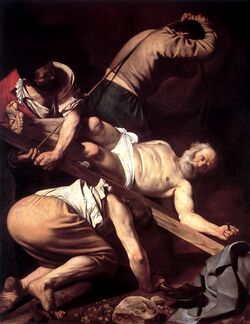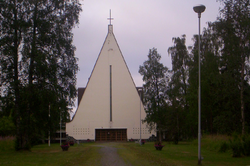Religion:Cross of Saint Peter
Error: no inner hatnotes detected (help).
The Cross of Saint Peter, also known as the Petrine Cross, is an inverted Latin cross traditionally used as a Christian symbol, but in recent times, it has also been used as an anti-Christian and Satanic symbol. In Christianity, it is associated with the martyrdom of Peter the Apostle. The symbol originates from the Catholic tradition that when sentenced to death, Peter requested that his cross be upside down, as he felt unworthy of being crucified in the same manner as Jesus.
In Christianity
The origin of the symbol comes from the belief that Peter the Apostle was crucified upside down,[1] as told by Origen of Alexandria. The tradition first appears in the "Martyrdom of Peter", a fragmented text found in, but possibly predating, the apocryphal Acts of Peter, which was written no later than 200 A.D. It is believed that Peter requested this form of crucifixion as he felt he was unworthy to be crucified in the same manner as Jesus. Another important Christian who died in the same way was Saint Philip, the apostle.
Occult symbol
The cross of Saint Peter has also been used for non-Christian symbolism. A 19th-century occult leader Eugène Vintras (fr), known for his claim to be the reincarnation of the Prophet Elijah, was the first to wear the inverted cross.[citation needed] Vintras and his followers were condemned by Pope Gregory XVI followers in an 1846 pamphlet, The Saints of Tilly-sur-Seulle, for homosexuality, conducting Black Masses in the nude, and masturbating on altars.[2]
Over time, the inverted cross came to be known more commonly as an occult symbol. Starting with the 1960s, several TV productions and movie franchises featured the inverted cross as a symbol representing the Antichrist and Satan making it one of the most popular satanic symbols today.[citation needed]
In popular culture
The inverted cross is a recurring motif in metal music, particularly in black metal in congruity with its anti-Christian themes. One well-known example is Glen Benton of the band Deicide who branded an inverted cross onto his forehead.[3]
Former Black Sabbath drummer Bill Ward suggested that the use of an inverted cross on the inner gatefold sleeve of their debut album by their label Vertigo may have been a promotional ploy or a misunderstanding of the nature of the group.[4]
The Swedish metal band Ghost makes use of the inverted cross in place of the final "t" in the band's wordmark, as well as on singer Papa Emeritus I's chasuble. Also, Ghost uses an inverted cross bisecting the letter G as their logo, the Grucifix.
Many horror films use inverted crosses as part of their imagery and marketing, especially if the film involves demonic themes. Examples include The Conjuring and Paranormal Activity. At the end of Rosemary's Baby, an upside down cross hangs over the bassinet containing Satan's son.[citation needed]
In the Chemin de la Croix by French composer Marcel Dupré, at the part where Simon of Cyrene helps Jesus carry the cross, an inverted cross motif appears at bar 7 and then twice more before it is replaced with a pastoral theme.[5]
See also
- Cross of Lorraine
References
- ↑ Our Christian Symbols by Friedrich Rest (ISBN:0-8298-0099-9), p. 29
- ↑ "Sex, Satanism & the 19th Century 'War of the Magicians'". 29 May 2015. https://www.historyanswers.co.uk/people-politics/prophets-black-masses-the-magic-war-of-19th-century-france/.
- ↑ "The 50 Most Evil Songs Ever". Kerrang!. https://www.kerrang.com/features/the-50-most-evil-songs-ever/.
- ↑ O'Neill, Christine. "Bill Ward: Black Sabbath inverted cross was a promotional ploy", Louder Sound, August 26, 2016
- ↑ Steed, Graham. The Organ Works of Marcel Dupré. Pendragon Press. p. 66. https://books.google.com/books?id=BJTRrnn9oJg. Retrieved 20 July 2019.
External links
 |




